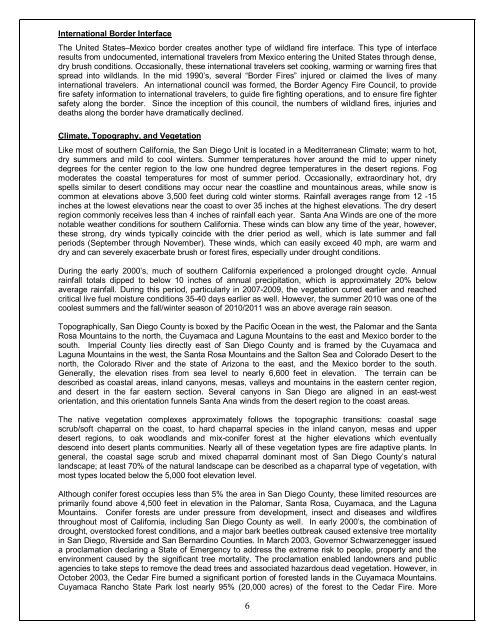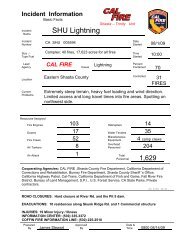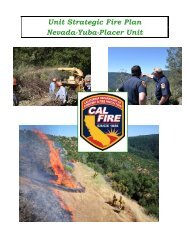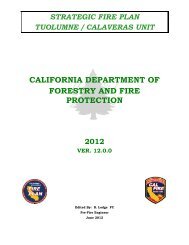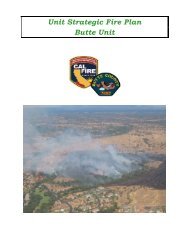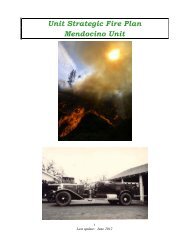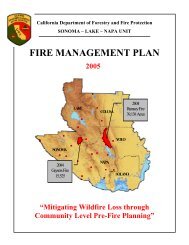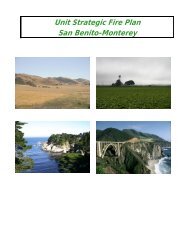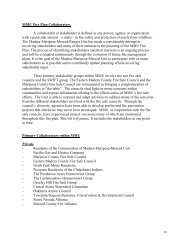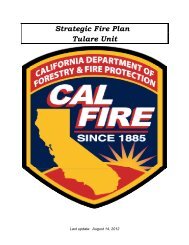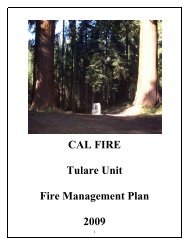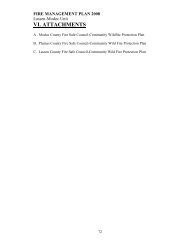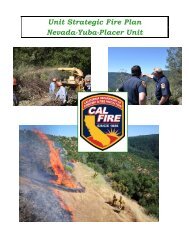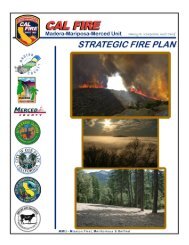Strategic Fire Plan San Diego Unit (MVU) - Board of Forestry and ...
Strategic Fire Plan San Diego Unit (MVU) - Board of Forestry and ...
Strategic Fire Plan San Diego Unit (MVU) - Board of Forestry and ...
You also want an ePaper? Increase the reach of your titles
YUMPU automatically turns print PDFs into web optimized ePapers that Google loves.
International Border Interface<br />
The <strong>Unit</strong>ed States–Mexico border creates another type <strong>of</strong> wildl<strong>and</strong> fire interface. This type <strong>of</strong> interface<br />
results from undocumented, international travelers from Mexico entering the <strong>Unit</strong>ed States through dense,<br />
dry brush conditions. Occasionally, these international travelers set cooking, warming or warning fires that<br />
spread into wildl<strong>and</strong>s. In the mid 1990’s, several “Border <strong>Fire</strong>s” injured or claimed the lives <strong>of</strong> many<br />
international travelers. An international council was formed, the Border Agency <strong>Fire</strong> Council, to provide<br />
fire safety information to international travelers, to guide fire fighting operations, <strong>and</strong> to ensure fire fighter<br />
safety along the border. Since the inception <strong>of</strong> this council, the numbers <strong>of</strong> wildl<strong>and</strong> fires, injuries <strong>and</strong><br />
deaths along the border have dramatically declined.<br />
Climate, Topography, <strong>and</strong> Vegetation<br />
Like most <strong>of</strong> southern California, the <strong>San</strong> <strong>Diego</strong> <strong>Unit</strong> is located in a Mediterranean Climate; warm to hot,<br />
dry summers <strong>and</strong> mild to cool winters. Summer temperatures hover around the mid to upper ninety<br />
degrees for the center region to the low one hundred degree temperatures in the desert regions. Fog<br />
moderates the coastal temperatures for most <strong>of</strong> summer period. Occasionally, extraordinary hot, dry<br />
spells similar to desert conditions may occur near the coastline <strong>and</strong> mountainous areas, while snow is<br />
common at elevations above 3,500 feet during cold winter storms. Rainfall averages range from 12 -15<br />
inches at the lowest elevations near the coast to over 35 inches at the highest elevations. The dry desert<br />
region commonly receives less than 4 inches <strong>of</strong> rainfall each year. <strong>San</strong>ta Ana Winds are one <strong>of</strong> the more<br />
notable weather conditions for southern California. These winds can blow any time <strong>of</strong> the year, however,<br />
these strong, dry winds typically coincide with the drier period as well, which is late summer <strong>and</strong> fall<br />
periods (September through November). These winds, which can easily exceed 40 mph, are warm <strong>and</strong><br />
dry <strong>and</strong> can severely exacerbate brush or forest fires, especially under drought conditions.<br />
During the early 2000’s, much <strong>of</strong> southern California experienced a prolonged drought cycle. Annual<br />
rainfall totals dipped to below 10 inches <strong>of</strong> annual precipitation, which is approximately 20% below<br />
average rainfall. During this period, particularly in 2007-2009, the vegetation cured earlier <strong>and</strong> reached<br />
critical live fuel moisture conditions 35-40 days earlier as well. However, the summer 2010 was one <strong>of</strong> the<br />
coolest summers <strong>and</strong> the fall/winter season <strong>of</strong> 2010/2011 was an above average rain season.<br />
Topographically, <strong>San</strong> <strong>Diego</strong> County is boxed by the Pacific Ocean in the west, the Palomar <strong>and</strong> the <strong>San</strong>ta<br />
Rosa Mountains to the north, the Cuyamaca <strong>and</strong> Laguna Mountains to the east <strong>and</strong> Mexico border to the<br />
south. Imperial County lies directly east <strong>of</strong> <strong>San</strong> <strong>Diego</strong> County <strong>and</strong> is framed by the Cuyamaca <strong>and</strong><br />
Laguna Mountains in the west, the <strong>San</strong>ta Rosa Mountains <strong>and</strong> the Salton Sea <strong>and</strong> Colorado Desert to the<br />
north, the Colorado River <strong>and</strong> the state <strong>of</strong> Arizona to the east, <strong>and</strong> the Mexico border to the south.<br />
Generally, the elevation rises from sea level to nearly 6,600 feet in elevation. The terrain can be<br />
described as coastal areas, inl<strong>and</strong> canyons, mesas, valleys <strong>and</strong> mountains in the eastern center region,<br />
<strong>and</strong> desert in the far eastern section. Several canyons in <strong>San</strong> <strong>Diego</strong> are aligned in an east-west<br />
orientation, <strong>and</strong> this orientation funnels <strong>San</strong>ta Ana winds from the desert region to the coast areas.<br />
The native vegetation complexes approximately follows the topographic transitions: coastal sage<br />
scrub/s<strong>of</strong>t chaparral on the coast, to hard chaparral species in the inl<strong>and</strong> canyon, mesas <strong>and</strong> upper<br />
desert regions, to oak woodl<strong>and</strong>s <strong>and</strong> mix-conifer forest at the higher elevations which eventually<br />
descend into desert plants communities. Nearly all <strong>of</strong> these vegetation types are fire adaptive plants. In<br />
general, the coastal sage scrub <strong>and</strong> mixed chaparral dominant most <strong>of</strong> <strong>San</strong> <strong>Diego</strong> County’s natural<br />
l<strong>and</strong>scape; at least 70% <strong>of</strong> the natural l<strong>and</strong>scape can be described as a chaparral type <strong>of</strong> vegetation, with<br />
most types located below the 5,000 foot elevation level.<br />
Although conifer forest occupies less than 5% the area in <strong>San</strong> <strong>Diego</strong> County, these limited resources are<br />
primarily found above 4,500 feet in elevation in the Palomar, <strong>San</strong>ta Rosa, Cuyamaca, <strong>and</strong> the Laguna<br />
Mountains. Conifer forests are under pressure from development, insect <strong>and</strong> diseases <strong>and</strong> wildfires<br />
throughout most <strong>of</strong> California, including <strong>San</strong> <strong>Diego</strong> County as well. In early 2000’s, the combination <strong>of</strong><br />
drought, overstocked forest conditions, <strong>and</strong> a major bark beetles outbreak caused extensive tree mortality<br />
in <strong>San</strong> <strong>Diego</strong>, Riverside <strong>and</strong> <strong>San</strong> Bernardino Counties. In March 2003, Governor Schwarzenegger issued<br />
a proclamation declaring a State <strong>of</strong> Emergency to address the extreme risk to people, property <strong>and</strong> the<br />
environment caused by the significant tree mortality. The proclamation enabled l<strong>and</strong>owners <strong>and</strong> public<br />
agencies to take steps to remove the dead trees <strong>and</strong> associated hazardous dead vegetation. However, in<br />
October 2003, the Cedar <strong>Fire</strong> burned a significant portion <strong>of</strong> forested l<strong>and</strong>s in the Cuyamaca Mountains.<br />
Cuyamaca Rancho State Park lost nearly 95% (20,000 acres) <strong>of</strong> the forest to the Cedar <strong>Fire</strong>. More<br />
6


